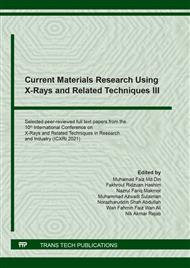p.3
p.9
p.14
p.20
p.26
p.33
p.39
p.49
The Effect of Graphite Loading as Reinforcement on Carbon Foam from Natural Resources
Abstract:
This study is to determine the effect of graphite as reinforcement material on natural resources carbon foam on the mechanical and physical properties. Sucrose is used as carbon precursor and graphite with various concentration from 0 wt% to 0.3 wt% was added into the carbon foam. Carbon foam was prepared by using template method followed by pre curing and carbonization process. Pre curing process was take place at 250°C and carbonization process was carried out at 900°C under inert atmosphere. The morphology, porosity, density and compressive strength were characterised in this experiment. Through Scanning Electron Microscope (SEM), graphite can be seen clearly embedded into the ‘window’ and fill the void space. Porosity of carbon foam decrease when the concentration of graphite increase and the density of carbon foam increase when the concentration of graphite increase. Carbon foam with 0.3 wt% graphite added shows the highest compressive strength (1.84 N/mm2) compared with carbon foam without graphite added (0.95 N/mm2). The properties of carbon foam are significantly influenced by the addition of graphite loading.
Info:
Periodical:
Pages:
9-13
Citation:
Online since:
January 2022
Keywords:
Price:
Сopyright:
© 2022 Trans Tech Publications Ltd. All Rights Reserved
Share:
Citation:


